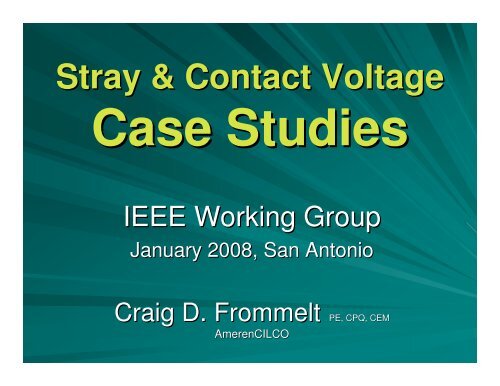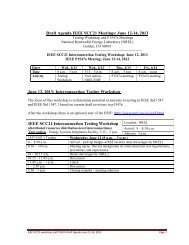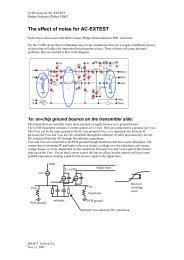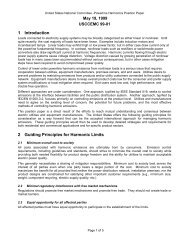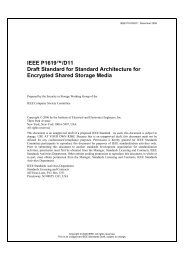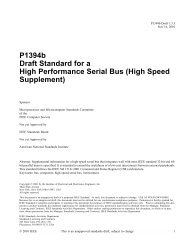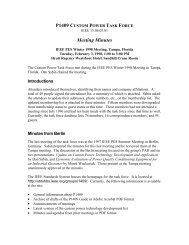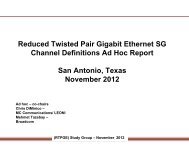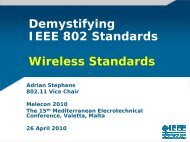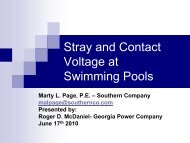Stray & Contact Voltage Case Studies - Working Group - IEEE
Stray & Contact Voltage Case Studies - Working Group - IEEE
Stray & Contact Voltage Case Studies - Working Group - IEEE
You also want an ePaper? Increase the reach of your titles
YUMPU automatically turns print PDFs into web optimized ePapers that Google loves.
<strong>Stray</strong> & <strong>Contact</strong> <strong>Voltage</strong><br />
<strong>Case</strong> <strong>Studies</strong><br />
<strong>IEEE</strong> <strong>Working</strong> <strong>Group</strong><br />
January 2008, San Antonio<br />
Craig D. Frommelt PE, CPQ, CEM<br />
AmerenCILCO
Topics<br />
Goals of this Session<br />
Brief Review of Terminology<br />
Brief Review of <strong>Stray</strong> & <strong>Contact</strong> <strong>Voltage</strong><br />
Sources<br />
Anatomy of a <strong>Case</strong> Study<br />
<strong>Case</strong>s:<br />
– Outdoor Faucet (Bad Neutral)<br />
– Basement Shower (Ground Fault)<br />
– Backyard Pool (Excess Ground Return Current)<br />
– Municipal Pool (Bad Neutral)
Goals of this Session<br />
Contribute to discussion on the Typical Sources<br />
of <strong>Stray</strong> & <strong>Contact</strong> <strong>Voltage</strong><br />
Propose a Straw Man for discussion on format<br />
for the <strong>Case</strong> <strong>Studies</strong> part of <strong>Working</strong> <strong>Group</strong>’s <strong>Group</strong> s<br />
product document<br />
Present selected <strong>Case</strong> <strong>Studies</strong> for Discussion<br />
and Comment
Terminology<br />
“<strong>Stray</strong> <strong>Stray</strong> <strong>Voltage</strong>” <strong>Voltage</strong> will refer to voltages that occur<br />
as a result of the NORMAL operation of the<br />
electric system.<br />
NORMAL may not be optimal
Terminology<br />
“<strong>Stray</strong> <strong>Stray</strong> <strong>Voltage</strong>” <strong>Voltage</strong> will refer to voltages that occur<br />
as a result of the NORMAL operation of the<br />
electric system.<br />
NORMAL may not be optimal<br />
“<strong>Contact</strong> <strong>Contact</strong> <strong>Voltage</strong>” <strong>Voltage</strong> will refer to voltages that result<br />
from ABNORMAL system conditions<br />
Open conductors, phase or neutral<br />
Shorted or Faulted conductors<br />
Wiring errors<br />
Insulation failures
Brief Review of<br />
<strong>Stray</strong> & <strong>Contact</strong> <strong>Voltage</strong> Sources<br />
Focus on High Neutral-to Neutral to-Earth Earth <strong>Voltage</strong>
Brief Review of<br />
<strong>Stray</strong> & <strong>Contact</strong> <strong>Voltage</strong> Sources<br />
Focus on High Neutral-to Neutral to-Earth Earth <strong>Voltage</strong><br />
Focus on Ground (Earth) Return Current<br />
NOT looking at Induced <strong>Voltage</strong>s (in ( this discussion<br />
in this discussion)
Brief Review of<br />
<strong>Stray</strong> & <strong>Contact</strong> <strong>Voltage</strong> Sources<br />
Focus on High Neutral-to Neutral to-Earth Earth <strong>Voltage</strong><br />
Focus on Ground Return Current<br />
NOT looking at Induced <strong>Voltage</strong>s<br />
Focus on a Really Simplistic Electric Model<br />
NOT showing all of the Transformers, Inductances, and<br />
Capacitances<br />
NOT showing all of the repeated parallel paths
Brief Review of<br />
<strong>Stray</strong> & <strong>Contact</strong> <strong>Voltage</strong> Sources<br />
Focus on High Neutral-to Neutral to-Earth Earth <strong>Voltage</strong><br />
Focus on Ground Return Current<br />
NOT looking at Induced <strong>Voltage</strong>s<br />
Focus on a Really Simplistic Electric Model<br />
NOT showing all of the Transformers, Inductances, and<br />
Capacitances<br />
NOT showing all of the repeated parallel paths<br />
Mention one possible source of <strong>Contact</strong> <strong>Voltage</strong>
Basic Electric Model<br />
-We must think of EE-201 “Fundamentals” (This is NOT Rocket Science so “KISS”)<br />
-Remember Kirchhoff's Law about the behavior of Currents:<br />
All of the Line Current must return to the source (substation transformer),<br />
to complete the ‘circuit’. And<br />
Currents will flow in ALL possible paths, inversely proportional to Impedances.<br />
-Remember Ohm’s Law :<br />
Currents flowing through Impedances ALWAYS create <strong>Voltage</strong> Drops<br />
(Potential Differences)
Basic Electric Model<br />
-Load Impedance is typically much higher than the Line + Neutral Impedances.<br />
-Neutral Impedance is NOT ZERO.
Basic Electric Model<br />
The model must also include the “Multiple Grounded Neutral”.
Basic Electric Model<br />
The model must also include the “Multiple Grounded Neutral”.<br />
Grounding Electrodes (Ground Rods) may have impedances<br />
to “Remote Earth” in the range of 10-50 ohms<br />
and can be much higher in dry soil, sand, or rock.
Basic Electric Model<br />
The model must also include the “Multiple Grounded Neutral”.<br />
Grounding Electrodes (Ground Rods) may have impedances<br />
to “Remote Earth” in the range of 10-50 ohms<br />
and can be much higher in dry soil, sand, or rock.<br />
Simpler to think of all of the impedance being at the<br />
ground rod interfaces to earth, with impedance of<br />
earth itself as near zero.
Electric Model<br />
Return Current “Divider Divider”<br />
Return current divides between Neutral and Earth return paths.<br />
Current follows ALL possible paths back to Substation.<br />
Current divides in ratios inversely proportional to impedances.
Electric Model<br />
Return Current “Divider Divider”<br />
Return current divides between Neutral and Earth return paths.<br />
Ideally, the earth impedance is 50 times or more higher than the neutral<br />
impedance, so there is relatively little earth (ground) return current.
Electric Model<br />
Return Current “Divider Divider”<br />
Return current generally flows “In To” the Earth near the remote ends<br />
of the feeder. So expect higher <strong>Stray</strong> <strong>Voltage</strong>s near 1-ph ends of a long<br />
feeder.<br />
Earth current then generally flows “Out Of” the Earth and back to the<br />
Neutral near the substation. So there is another likelihood of <strong>Stray</strong><br />
<strong>Voltage</strong>s very near the substation, even if 3-phase.<br />
Generally, little to no <strong>Stray</strong> <strong>Voltage</strong> in the center of the circuit,<br />
at maybe 1-3 miles from the substation.
Basic Electric Model<br />
Ohm’s Law:<br />
Current flowing through these neutral to earth Impedances<br />
(grounding electrode impedances) always causes a <strong>Voltage</strong> drop.<br />
Normally it is very small ( maybe 0.010 – 0.500 volts ) but never ZERO.
Basic Electric Model<br />
Most Likely “Human Human” Touch Potential<br />
Most “Human” stray voltage complaints arise in areas where people<br />
can touch “grounded’ metal parts and “earth”, with bare wet hands & feet .<br />
In this context, “Grounded” usually means<br />
“Bonded to the Neutral and the Top of the Ground Rods”.
Basic Electric Model<br />
“<strong>Stray</strong> <strong>Stray</strong>” <strong>Voltage</strong> Source - A<br />
Most frequent source of the problem is a higher than normal Neutral impedance.<br />
Maybe high impedance connections.<br />
Maybe corroded URD concentric neutrals, or broken strands in OH wires<br />
May simply be long 1-ph taps with small neutral conductors.<br />
Results in higher than normal grounding electrode currents and voltage drops.
Basic Electric Model<br />
“<strong>Stray</strong> <strong>Stray</strong>” <strong>Voltage</strong> Source - B<br />
Another frequent cause, or contributing factor, is higher than normal<br />
1-ph load currents. (Relative to conductor sizes)<br />
High Load Currents means that the Load Impedance is getting smaller,<br />
relative to conductor impedances.<br />
Thus, there is relatively more <strong>Voltage</strong> Drop elsewhere in the circuit,<br />
such as across the Neutral and across the Ground Rods.
Basic Electric Model<br />
A “<strong>Contact</strong> <strong>Contact</strong>” <strong>Voltage</strong> Source<br />
One likely source of “<strong>Contact</strong> <strong>Voltage</strong>” on a neutral is a nearby Ground Fault.<br />
Can be primary or secondary voltage.<br />
Maybe a grounded secondary conductor.<br />
Maybe a wire insulation failure, such as on a submersible water pump.<br />
This ground Current ‘returns to the neutral’ through the grounding electrodes,<br />
resulting in higher than normal electrode <strong>Voltage</strong> drops.
Anatomy of a <strong>Case</strong> Study<br />
(A Straw Man)<br />
Details of Customer Complaint<br />
Previous Actions & Findings by Service<br />
Technician<br />
Engineering Diagnostic Actions & Findings<br />
Problem Cause (Classification)<br />
Remedial Actions Taken<br />
Results<br />
Any Next Steps
We will Discuss 4 <strong>Case</strong> <strong>Studies</strong>:<br />
–Outdoor Outdoor Faucet<br />
–Basement Basement Shower<br />
–Backyard Backyard Pool<br />
–Municipal Municipal Pool
<strong>Case</strong>s:<br />
–#1 #1 Outdoor Faucet<br />
– #2 Basement Shower<br />
– #3 Backyard Pool<br />
– #4 Municipal Pool
<strong>Case</strong> #1 - Outdoor Faucet<br />
Customer Complaint:<br />
– Kids getting “Tingled Tingled”<br />
while filling water<br />
balloons at outdoor<br />
faucet<br />
– Customer measured<br />
voltages as high as<br />
10 VAC
<strong>Case</strong> #1 - Outdoor Faucet<br />
Previous Actions & Findings by Service<br />
Technician:<br />
– Confirmed 5 VAC measurement at faucet<br />
Weather was cooling, so all Loads were going down<br />
Not unusual for these voltage measurements to vary over time<br />
– Checked all grounds and bonds – OK<br />
– Called Engineering
<strong>Case</strong> #1 - Outdoor Faucet<br />
Engineering Diagnostic Actions & Findings:<br />
– Confirmed “<strong>Stray</strong> <strong>Stray</strong> <strong>Voltage</strong>” <strong>Voltage</strong> measurements.<br />
– <strong>Voltage</strong> measured several times, and seen to be load<br />
dependent (Increased ( Increased during the ‘Heat Heat’ of the day) day<br />
– Confirmed all Grounds and Bonds to be “OK OK”
<strong>Case</strong> #1 - Outdoor Faucet<br />
Engineering Diagnostic Actions & Findings:<br />
– Location is near end of 1-ph 1 ph Tap, 4 miles from Substation.
<strong>Case</strong> #1 - Outdoor Faucet<br />
Engineering Diagnostic Actions & Findings:<br />
– Location is near end of 1-ph 1 ph Tap, distant from Substation.<br />
– Significant 1-ph 1 ph loads downstream of this customer.
<strong>Case</strong> #1 - Outdoor Faucet<br />
Engineering Diagnostic Actions & Findings:<br />
– Location is near end of 1-ph 1 ph Tap, distant from Substation.<br />
– Significant 1-ph 1 ph loads downstream of this customer.<br />
– <strong>Stray</strong> voltage measurable at neighbors,<br />
but no complaints from them.<br />
– Previous reports from Construction of<br />
URD cable neutral corrosion in this area.<br />
– Impractical to replace all of this URD Cable,<br />
as not failing yet. (We do not replace due to neutral corrosion)
<strong>Case</strong> #1 - Outdoor Faucet<br />
Engineering Diagnostic Actions & Findings:<br />
– Location is near end of 1-ph 1 ph Tap, distant from Substation.<br />
– Significant 1-ph 1 ph loads downstream of this customer.<br />
– <strong>Stray</strong> voltage measurable at neighbors,<br />
but no complaints from them.<br />
– Previous reports from Construction of<br />
URD cable neutral corrosion in this area.<br />
– Impractical to replace all of this URD Cable,<br />
as not failing yet. (We do not replace due to neutral corrosion)<br />
– Verified that lifting the Service Neutral fixed the problem.
<strong>Case</strong> #1 - Outdoor Faucet<br />
Problem Cause (Classification)<br />
Substation<br />
Transformer<br />
High Neutral<br />
Impedance<br />
Load<br />
Neutral to Earth<br />
<strong>Voltage</strong><br />
SOURCE
<strong>Case</strong> #1 - Outdoor Faucet<br />
Remedial Actions Taken:<br />
– Installed 2 nd ground rod near Customer Meter<br />
(Impedance went down, Current went up,<br />
No <strong>Voltage</strong> Change)<br />
– Installed 2 nd ground rod at Pad Transformer<br />
(No significant affect)
<strong>Case</strong> #1 - Outdoor Faucet<br />
Remedial Actions Taken:<br />
– Installed 2 nd ground rod near Customer Meter<br />
(Impedance went down, Current went up,<br />
No <strong>Voltage</strong> Change)<br />
– Installed 2 nd ground rod at Pad Transformer<br />
(No significant affect)<br />
– Learning what DOESN’T DOESN T WORK
<strong>Case</strong> #1 - Outdoor Faucet<br />
Remedial Actions<br />
Taken:<br />
Installed Neutral<br />
Isolator in Pad<br />
Transformer
<strong>Case</strong> #1 - Outdoor Faucet<br />
Remedial Actions<br />
Taken:<br />
Installed Neutral Isolator<br />
in Pad Transformer<br />
Cannot just leave<br />
neutral Open, as that<br />
results in a safety<br />
hazard and NEC<br />
Code Violation
<strong>Case</strong> #1 - Outdoor Faucet<br />
Remedial Actions<br />
Taken:<br />
Installed Neutral Isolator in<br />
Pad Transformer<br />
Neutral Isolator can be:<br />
- Spark Gap Arrester<br />
- MOV Arrester<br />
- Saturated Core Reactor<br />
(Ronk Ronk Blocker) Blocker<br />
Must Conduct any<br />
Ground-Fault Ground Fault Currents
<strong>Case</strong> #1 - Outdoor Faucet<br />
Remedial<br />
Actions Taken:<br />
– Installed Neutral<br />
Isolator in Pad<br />
Transformer<br />
– 120/240 Volt<br />
MOV Arrester
<strong>Case</strong> #1 - Outdoor Faucet<br />
Results<br />
– <strong>Voltage</strong> reduced to less than 1.0 VAC.<br />
– Declare success and “Walk Walk Away”.<br />
Away
<strong>Case</strong> #1 - Outdoor Faucet<br />
Any Next Steps<br />
– Advise customer to call again if voltage<br />
re-appears re appears next summer as loads go<br />
back up.<br />
(We did this in the Fall, and loads were way down<br />
from Peak)
<strong>Case</strong>s:<br />
– #1 Outdoor Faucet<br />
–#2 #2 Basement Shower<br />
– #3 Backyard Pool<br />
– #4 Municipal Pool
<strong>Case</strong> #2 - Basement Shower<br />
Customer Complaint:<br />
Rural home. Getting shocked in basement<br />
shower, when touch water valves.<br />
Started 2-3 2 3 weeks before investigation.
<strong>Case</strong> #2 - Basement Shower<br />
Previous Actions & Findings by Service<br />
Technician<br />
– Measured 6.4 – 7.0 VAC in shower, between<br />
water handles and metal drain cap in floor.<br />
– Disconnect hot leads at the meter (No Affect)<br />
– Disconnect service neutral at meter (No Affect)<br />
– So, call Engineering for assistance
<strong>Case</strong> #2 - Basement Shower<br />
Engineering Diagnostic Actions & Findings<br />
– Verify measurement of 3.5 volts in shower<br />
– Measured ground impedance of 18 ohms and<br />
ground rod current of 0.194 amps (calcs calcs to 3.492 volts)<br />
– Verified no affect from hot leg and neutral disconnections<br />
– Added water pipes to ground bond (No Affect)<br />
– Verified integrity of neutral connections (All OK)<br />
– Discussed situation with customer. Verified that problem<br />
started about same time as neighbor’s neighbor s electric problem.
<strong>Case</strong> #2 - Basement Shower<br />
Engineering Diagnostic Actions & Findings<br />
– Pulled cut-out cut out for the complaint location, with no affect.<br />
– Pulled cut-out cut out for neighbor across street, stray voltage<br />
disappeared.
<strong>Case</strong> #2 - Basement Shower<br />
Engineering Diagnostic Actions & Findings<br />
– Inspected neighbor’s neighbor s farm operation, no farm house<br />
– Farmer showed-up showed up and offered to help
<strong>Case</strong> #2 - Basement Shower<br />
Engineering Diagnostic Actions & Findings<br />
– 4 branch circuits from meter pole
<strong>Case</strong> #2 - Basement Shower<br />
Engineering Diagnostic Actions & Findings<br />
– Customer suggested overhead circuit, which had been torn<br />
down by a combine, and reattached by the farmer.
<strong>Case</strong> #2 - Basement Shower<br />
Engineering Diagnostic Actions & Findings<br />
– With aid of Troubleman, disconnected branch circuits one<br />
at a time and made measurements.<br />
– Confirmed that the overhead circuit was the source of the<br />
problem.<br />
– Checked wiring in that building, found everything OK.<br />
– Opening the breakers in that building, no affect.
<strong>Case</strong> #2 - Basement Shower<br />
Engineering Diagnostic Actions & Findings<br />
– Lights and garage door opener worked OK<br />
– Checked ground rod for good bonding<br />
– Could not get an impedance measurement (meter error)<br />
– 3-4 4 amps in ground rod, even with breaker open<br />
– Did NOT feel any voltage on the ground rod
<strong>Case</strong> #2 - Basement Shower<br />
Engineering Diagnostic Actions &<br />
Findings<br />
– Checked continuity of the 2 branch circuit conductors<br />
– Verified that they had been REVERSED when reconnected<br />
by the farmer after the accident with the combine.
<strong>Case</strong> #2 - Basement Shower<br />
Problem Cause (Classification)<br />
Ground Fault
<strong>Case</strong> #2 - Basement Shower<br />
Problem Cause (Classification)<br />
Ground Fault<br />
Initially investigated as a<br />
“<strong>Stray</strong> <strong>Stray</strong> <strong>Voltage</strong>” <strong>Voltage</strong> type complaint<br />
Due to underlying cause, this would be<br />
classified as a “<strong>Contact</strong> <strong>Contact</strong> <strong>Voltage</strong>” <strong>Voltage</strong> issue.<br />
The miswiring constitutes an ABNORMAL<br />
system condition.
<strong>Case</strong> #2 - Basement Shower<br />
Remedial Actions Taken<br />
– The overhead service wires to the barn were<br />
returned to their correct connections by the<br />
Troubleman.
<strong>Case</strong> #2 - Basement Shower<br />
Results<br />
– Measured voltage in the shower was reduced<br />
to 0.500 V AC.
<strong>Case</strong> #2 - Basement Shower<br />
Results<br />
– Measured voltage in the shower was reduced<br />
to 0.500 V AC.<br />
Within expected voltage range for a customer on a long rural tap<br />
Our “walk walk-away away” level is 1.0 volts AC, so <strong>Case</strong> Closed
<strong>Case</strong> #2 - Basement Shower<br />
Any Next Steps<br />
– No follow-up follow up actions were required
<strong>Case</strong> #2 - Basement Shower<br />
Pop Quiz<br />
– I left out one important bit of information<br />
– What is missing from the story?
<strong>Case</strong>s:<br />
– #1 Outdoor Faucet<br />
– #2 Basement Shower<br />
–#3 #3 Backyard Pool<br />
– #4 Municipal Pool
<strong>Case</strong> #3 – Back Yard Pool<br />
Customer Complaint:<br />
– Newly installed in-ground in ground<br />
pool<br />
– Immediately felt ‘tingling tingling’<br />
when using metal hand<br />
rail to exit the pool<br />
– Measured 1.5 – 2.5 VAC<br />
between hand rail and<br />
pool water
<strong>Case</strong> #3 – Back Yard Pool<br />
Previous Actions & Findings by Service<br />
Technician:<br />
– No field investigation was performed by Operations<br />
– Engineering was called immediately
<strong>Case</strong> #3 – Back Yard Pool<br />
Engineering Diagnostic Actions & Findings:<br />
– Met customer electrician at the site<br />
Quickly determined that he was not “Licensed Licensed”<br />
– Started to investigate multiple complaints:<br />
GFI Breaker on pool pump would not stay closed<br />
TV in house was recently damaged during a lightning storm<br />
Tingling on pool hand rail
<strong>Case</strong> #3 – Back Yard Pool<br />
Engineering Diagnostic Actions & Findings<br />
– Inspected wiring at main entrance panel and<br />
sub-panel sub panel at the pool.
<strong>Case</strong> #3 – Back Yard Pool<br />
Engineering Diagnostic Actions & Findings<br />
– Inspected wiring at main entrance panel and sub-panel sub panel at<br />
the pool.<br />
“Amateur Amateur” electrician had bonded the neutral to the case ground at<br />
the pool sub-panel, sub panel, creating a ground-loop. ground loop. Lifting that illegal jumper<br />
fixed the GFI breaker problem<br />
There were no bonds between the CATV service and the Electric<br />
service and the CATV was not grounded at all. Advised customer to to<br />
call CATV company to get their service properly grounded, to avoid avoid<br />
future lightning problems
<strong>Case</strong> #3 – Back Yard Pool<br />
Engineering Diagnostic Actions & Findings:<br />
– Inspected the grounding and bonding around the pool
<strong>Case</strong> #3 – Back Yard Pool<br />
Engineering Diagnostic Actions & Findings:<br />
– Inspected the grounding and bonding around the pool<br />
Observed ground rods at the meter, at the pump sub-panel, sub panel, and at the far<br />
end of the pool.<br />
Observed multiple grounding conductors attached to ground-rods ground rods around<br />
the pool<br />
Were told by “electrician electrician” that the pump, pool lights, powered pool cover,<br />
and all metal fittings and fixtures were bonded to this ground grid grid
<strong>Case</strong> #3 – Back Yard Pool<br />
Engineering Diagnostic Actions & Findings:<br />
– Inspected utility service to the residence
<strong>Case</strong> #3 – Back Yard Pool<br />
Engineering Diagnostic Actions & Findings:<br />
– Inspected utility service to the residence<br />
Disconnecting hot-leads hot leads had no affect on <strong>Stray</strong> <strong>Voltage</strong><br />
Disconnecting neutral at meter lowered <strong>Stray</strong> <strong>Voltage</strong>,<br />
but not by enough to call it fixed.<br />
All hot, neutral, and ground connections were restored and verified verified<br />
tight<br />
(No affect)<br />
Two additional ground-rods ground rods were driven at transformer (No affect)
<strong>Case</strong> #3 – Back Yard Pool<br />
Engineering Diagnostic Actions & Findings:<br />
– Inspected utility service to the residence<br />
Disconnecting hot-leads hot leads had no affect on <strong>Stray</strong> <strong>Voltage</strong><br />
Disconnecting neutral at meter lowered <strong>Stray</strong> <strong>Voltage</strong>, but not by enough to call it fixed.<br />
All hot, neutral, and ground connections were restored and verified verified<br />
tight<br />
(No affect)<br />
Two additional ground-rods ground rods were driven at transformer (No affect)<br />
– Tested lines into subdivision (looking for Ground Faults or Bad Neutrals)
<strong>Case</strong> #3 – Back Yard Pool<br />
Engineering Diagnostic Actions & Findings:<br />
– Inspected utility service to the residence<br />
Disconnecting hot-leads hot leads had no affect on <strong>Stray</strong> <strong>Voltage</strong><br />
Disconnecting neutral at meter lowered <strong>Stray</strong> <strong>Voltage</strong>, but not by enough to call it fixed.<br />
All hot, neutral, and ground connections were restored and verified verified<br />
tight<br />
(No affect)<br />
Two additional ground-rods ground rods were driven at transformer (No affect)<br />
– Tested line into subdivision<br />
Identified 2 cut-outs cut outs serving 2 sides of UG loop in subdivision<br />
Opened cut-outs cut outs one at a time (Each ( Each time <strong>Stray</strong> <strong>Voltage</strong> went down to about half) half<br />
Checked neutral connections on OH line for 1.5 miles back to 3-ph 3 ph main line<br />
(All All connections good) good<br />
Measured phase and neutral currents on OH line<br />
– 14 amps phase current<br />
– Only 10 amps neutral return current
<strong>Case</strong> #3 – Back Yard Pool<br />
Engineering Diagnostic Actions & Findings:<br />
– Inspected utility service to the residence<br />
Disconnecting hot-leads hot leads had no affect on <strong>Stray</strong> <strong>Voltage</strong><br />
Disconnecting neutral at meter lowered <strong>Stray</strong> <strong>Voltage</strong>, but not by enough to call it fixed.<br />
All hot, neutral, and ground connections were restored and verified verified<br />
tight<br />
(No affect)<br />
Two additional ground-rods ground rods were driven at transformer (No affect)<br />
– Tested service to neighbors (looking for Ground Faults)<br />
Identified 2 cut-outs cut outs serving 2 sides of UG loop in subdivision<br />
Opened cut-outs cut outs one at a time (Each time <strong>Stray</strong> <strong>Voltage</strong> went down to about half)<br />
Checked neutral connections on OH line for 1.5 miles back to 3-ph 3 ph main line (All connections good)<br />
Measured phase and neutral currents on OH line<br />
– 14 amps phase current<br />
– Only 10 amps neutral return current<br />
– Conclusion:<br />
High 1-ph 1 ph loads at distance from substation was resulting in significant significant<br />
earth return currents<br />
No observed or suggested neutral impedance problems, nothing to fix<br />
What we were seeing was “normal normal” earth return currents situation
<strong>Case</strong> #3 – Back Yard Pool<br />
Engineering Diagnostic Actions & Findings:<br />
– Systematically re-checked re checked our measurements,<br />
observations, and what we had been told by the customer<br />
– Observed that pool water was at “Remote Remote Earth” Earth potential,<br />
but that the ground-rods ground rods were not. And, the three ground<br />
rods were not at the same potentials relative to remote<br />
earth.<br />
– Discovered that <strong>Stray</strong> <strong>Voltage</strong> went away when we added a<br />
bond between the pool hand rail and the nearest ground<br />
rod.
<strong>Case</strong> #3 – Back Yard Pool<br />
Engineering Diagnostic Actions & Findings:<br />
– Systematically re-checked re checked our measurements, observations, and what we had been told told<br />
by the customer<br />
– Observed that pool water was at “Remote Remote Earth” Earth potential, but that the ground-rods ground rods were<br />
not. And, the three ground rods were not at the same potentials relative to remote earth.<br />
– Discovered that <strong>Stray</strong> <strong>Voltage</strong> went away when we added a bond between between<br />
the pool hand<br />
rail and the nearest ground rod.<br />
– CONCLUSION:<br />
The “Amateur Amateur” electrician and / or pool installer did not understand<br />
NEC requirements for pool area grounding and bonding.<br />
There was no equipotential grid around this pool.
.<br />
<strong>Case</strong> #3 – Back Yard Pool<br />
Problem Cause (Classification)<br />
– This was not a Utility problem<br />
– It represented NORMAL electric operation<br />
– Nothing for us to fix.<br />
This is a Customer Problem.
<strong>Case</strong> #3 – Back Yard Pool<br />
Remedial Actions Taken<br />
– Nothing for utility to fix.<br />
Neutral isolation would not fix problem.<br />
Not practical to run 3-ph 3 ph for 1.5 miles to balance<br />
and thus cancel earth return currents<br />
– Left our ‘temporary temporary’ bonding conductor in<br />
place, so customer could verify our findings<br />
– Advised customer that it was his<br />
responsibility to bring his pool up to<br />
NEC Code Compliance.
<strong>Case</strong> #3 – Back Yard Pool<br />
Any Next Steps:<br />
– Advised customer to hire electrician to correctly bond<br />
all metal fixtures in pool area.<br />
– Advised customer to call back if that did not fix the<br />
problem
<strong>Case</strong>s:<br />
– #1 Outdoor Faucet<br />
– #2 Basement Shower<br />
– #3 Backyard Pool<br />
–#4 #4 Municipal Pool
<strong>Case</strong> #4 – Municipal Pool<br />
Customer<br />
Complaint:<br />
– “Shocking Shocking”<br />
voltages felt in<br />
the Snack Bar<br />
– Closed pool for<br />
the season<br />
(Early)
<strong>Case</strong> #4 – Municipal Pool<br />
Customer Complaint:<br />
– Snack bar kitchen volunteers are getting<br />
shocked around the sink
<strong>Case</strong> #4 – Municipal Pool<br />
Previous Actions & Findings by<br />
Service Technicians<br />
– Initial measurements between<br />
plumbing and metal electric<br />
conduits in kitchen were in the<br />
8 – 10 VAC range.<br />
– Line crews found and fixed a<br />
nearby primary neutral connection,<br />
which reduced measurements to<br />
2-3 3 VAC range.<br />
– Then called for Engineering<br />
assistance
<strong>Case</strong> #4 – Municipal Pool<br />
Engineering Diagnostic Actions & Findings:<br />
– Confirmed neutral to ground voltage in 2-3 2 3 VAC range<br />
– Inspected customer wiring panels for proper ground-neutral<br />
ground neutral<br />
bonds and proper grounding<br />
– Found a REAL MESS.<br />
Looked like the work of multiple ‘volunteers volunteers’<br />
Conductor color-coding color coding was non-existent non existent<br />
Neutrals and safety grounds all tangled<br />
Advised customer to call-in call in a licensed electrician and bring<br />
up to Code before someone got hurt
<strong>Case</strong> #4 – Municipal Pool<br />
Engineering Diagnostic Actions & Findings<br />
– Identified complaint location to be very near Substation<br />
with lots of downstream 1-phase 1 phase loads.
<strong>Case</strong> #4 – Municipal Pool<br />
Engineering Diagnostic Actions & Findings<br />
– Formed a Hypothesis:<br />
Likely more bad neutral connections on circuit<br />
Likely downstream from this location<br />
Could be anywhere on a LONG feeder<br />
Time and effort required to find and fix all of them would<br />
be prohibitive, with relatively small payback.<br />
Remaining voltage was measurable, but not a safety<br />
hazard and likely not noticeable in ‘dryer dryer’ locations
<strong>Case</strong> #4 – Municipal Pool<br />
Engineering Diagnostic Actions & Findings<br />
– Formed a Hypothesis:<br />
Likely more bad neutral connections on circuit<br />
Likely downstream from this location<br />
Could be anywhere on a LONG feeder<br />
Time and effort required to find and fix all of them would be prohibitive, prohibitive,<br />
with<br />
relatively small payback.<br />
Remaining voltage was measurable, but not a safety hazard and likely likely<br />
not<br />
noticeable in ‘dryer dryer’ locations<br />
Lifted the service neutral and verified that the<br />
<strong>Stray</strong> <strong>Voltage</strong> disappeared.
<strong>Case</strong> #4 – Municipal Pool<br />
Engineering Diagnostic Actions & Findings<br />
– Formed a Hypothesis:<br />
Likely more bad neutral connections on circuit<br />
Likely downstream from this location<br />
Time and effort required to find and fix all of them would<br />
be prohibitive, with relatively small payback.<br />
Remaining voltage was measurable, but not a safety hazard and likely likely<br />
not noticeable in ‘dryer dryer’<br />
locations<br />
– Conclusion:<br />
Good candidate for “Fix Fix the Symptom” Symptom<br />
Recommended installing a Neutral Isolator
<strong>Case</strong> #4 – Municipal Pool<br />
Problem Cause (Classification):<br />
Neutral to Earth<br />
<strong>Voltage</strong><br />
Substation<br />
Transformer<br />
Load<br />
Earth currents returning to neutral near substation
<strong>Case</strong> #4 – Municipal Pool<br />
Remedial Actions Taken<br />
– Crew installed neutral isolator.
<strong>Case</strong> #4 – Municipal Pool<br />
Results<br />
– Measured voltage reduced to 0.3 to 0.5 VAC<br />
range.<br />
– Our “Walk Walk-Away Away” voltage is 1.0 VAC<br />
so we declared success and quit.
<strong>Case</strong> #4 – Municipal Pool<br />
Any Next Steps:<br />
Recommended customer electrician bring wiring up to<br />
Code.<br />
Told customer to call back if problem returned when the<br />
Pool re-opened re opened next Spring
In Summary<br />
We Discussed 4 <strong>Case</strong> <strong>Studies</strong>:<br />
–Outdoor Outdoor Faucet (Bad Neutral)<br />
–Basement Basement Shower (Ground Fault)<br />
–Backyard Backyard Pool (Excess Ground Return Current)<br />
–Municipal Municipal Pool (Bad Neutral)
Closing Summary<br />
Presented a Really Simplified Electric Model<br />
Discussed some Likely Sources of<br />
<strong>Stray</strong> & <strong>Contact</strong> <strong>Voltage</strong>s<br />
Discussed Proposed Format for <strong>Case</strong> <strong>Studies</strong><br />
Presented Example <strong>Case</strong> <strong>Studies</strong>
Closing<br />
Presented a Really Simplified Electric Model<br />
Discussed some Likely Sources of<br />
<strong>Stray</strong> & <strong>Contact</strong> <strong>Voltage</strong>s<br />
Discussed Proposed Format for <strong>Case</strong> <strong>Studies</strong><br />
Presented Example <strong>Case</strong> <strong>Studies</strong><br />
Questions or Discussion ??


